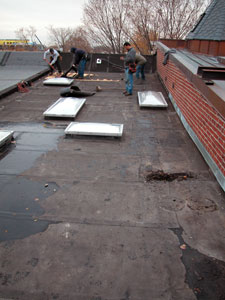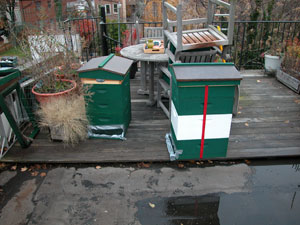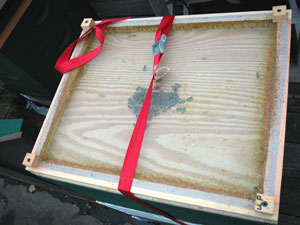 In August of last year, roofers next door outed the bees to our south-side neighbors, resulting in just 4 months of undetected beekeeping. Luckily, those neighbors are a little paranoid, too; they also thought the bees were cool, and decided to keep the matter to themselves. Then, this Spring, the north side neighbor got a new roof, and I became really worried, because Kathy is a normal, well-adjusted person with children and her reactions would therefore be alien to me. But it turns out that her roofers never told her, and as a result I outed myself last month (sort of) and she was kind of happy about the whole thing.
In August of last year, roofers next door outed the bees to our south-side neighbors, resulting in just 4 months of undetected beekeeping. Luckily, those neighbors are a little paranoid, too; they also thought the bees were cool, and decided to keep the matter to themselves. Then, this Spring, the north side neighbor got a new roof, and I became really worried, because Kathy is a normal, well-adjusted person with children and her reactions would therefore be alien to me. But it turns out that her roofers never told her, and as a result I outed myself last month (sort of) and she was kind of happy about the whole thing.And now our roof leaks have reached critical (Editor's note: the leaks are nowhere near the beehives), so we have a team of roofers doing their thing up above today. The nice thing is, they like bees.
Messing with a roof is usually complicated these days – we have a satellite dish and a heat pump as well as a deck and some beehives up there. I've had a parade of workers tromping up there to disconnect and reconnect and move and otherwise get themselves introduced to the amazing life of urban rooftop bees. And here is the truth: between all the roofers north and south, the AC and the satellite guys, the folks who wrote up estimates for this and that, a total of over twenty people, not one single person had a breakdown over the bees.
Andre, the leader of the team up there today, was actually pretty excited. Back where he is from (El Salvador), lots of people keep a hive or two, and he had never seen a hive in the US. Juan, the (formerly) Dominican AC technician, used the bees as a reason to talk about his cat and aquariums he has known.
 But you might be asking, what about the bees today? Well, they had to be moved onto the deck (which is not being messed with) and they had to be sealed in, because otherwise they would get lost.
But you might be asking, what about the bees today? Well, they had to be moved onto the deck (which is not being messed with) and they had to be sealed in, because otherwise they would get lost.The rule about moving bees is this: "either less than 3 feet or more than a mile." Bees build complex mental maps for where their home is located, basing them on things like large immovable landmarks and the angle of the sun. If you move a hive even 10 feet, the foragers will fly out, and then fly back to where their hive USED to be, hovering confusedly over the old spot. If you move them beyond their likely internal map, like 3 miles, they fly out, get confused immediately, and begin rewriting the map.
 So last night, after sunset (when all the field bees should be back home) I went up and blocked the entrances with plastic window screen material and duct tape, and covered the top with a screen that is usually used for added summer ventilation. Then you run a lashing strap around the hives (the kind with a clip that gets tighter as you tug on it, and you release by flipping a lever). The result is a bunch of hive bodies that are held tightly together while you pick them up by the handles on the bottom box.
So last night, after sunset (when all the field bees should be back home) I went up and blocked the entrances with plastic window screen material and duct tape, and covered the top with a screen that is usually used for added summer ventilation. Then you run a lashing strap around the hives (the kind with a clip that gets tighter as you tug on it, and you release by flipping a lever). The result is a bunch of hive bodies that are held tightly together while you pick them up by the handles on the bottom box.Two guys moved the Wilde hive easily, though it was heavy enough. Things went a bit less well with Twain. There was still some water in the hivetop feeder (the side that didn't leak) and the guys staggered a bit when it washed over them. This joggled the bees quite a lot, and may have soaked some with cold, sticky sugar water. I hope no one was injured or gets sick from this! There have been some deformed wing girls emerging from Twain lately, and this is the colony (after the Mill girls) which concerns me most. Oh, I hope that Queen Abigail is OK.
The roofers agreed to build me a special reinforced pad and walkway to the bees, which is a good thing, and a place we may be able to move back to at the end of today. I'll take a quick look in tomorrow to see what the state of the colonies is after all this banging and moving.
November is as good a time as any for sealing up bees around here. There is little forage out there, and the bees are not so tightly clustered during the day that we were likely to crush lots of them when moving their homes. It's not so hot that they will overheat in there, either. The roof color should be lighter, now, so it won't get so hot in summer. If I can just keep them alive through this winter, it should be a nicer place to bee in 2007.
2 comments:
Congrats on the blue!
Hi there, I just completed my first year of beekeeping. I have my bees at a friends house, but am attempting to convince my condo neighbors into letting me have a hive or two on the property somewhere. The roof is one of the proposed spots. I am interested to see how your roof beekeeping goes!
my beeblog: kristasbeelog.blogspot.com
Post a Comment